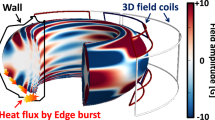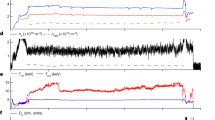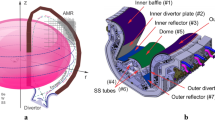Abstract
In the quest for new energy sources, the research on controlled thermonuclear fusion1 has been boosted by the start of the construction phase of the International Thermonuclear Experimental Reactor2 (ITER). ITER is based on the tokamak magnetic configuration3, which is the best performing one in terms of energy confinement. Alternative concepts are however actively researched, which in the long term could be considered for a second generation of reactors. Here, we show results concerning one of these configurations, the reversed-field pinch4,5 (RFP). By increasing the plasma current, a spontaneous transition to a helical equilibrium occurs, with a change of magnetic topology. Partially conserved magnetic flux surfaces emerge within residual magnetic chaos, resulting in the onset of a transport barrier. This is a structural change and sheds new light on the potential of the RFP as the basis for a low-magnetic-field ohmic fusion reactor.
This is a preview of subscription content, access via your institution
Access options
Subscribe to this journal
Receive 12 print issues and online access
$259.00 per year
only $21.58 per issue
Buy this article
- Purchase on SpringerLink
- Instant access to full article PDF
Prices may be subject to local taxes which are calculated during checkout




Similar content being viewed by others
References
Freidberg, J. Plasma Physics and Fusion Energy (Cambridge Univ. Press, 2007).
The ITER physics basis. Nucl. Fusion 47, S1–S413 (2007).
Wesson, J. Tokamaks 3rd edn (Oxford Univ. Press, 2004).
Ortolani, S. & Schnack, D. D. Magnetohydrodynamics of Plasma Relaxation (World Scientific, 1993).
Martin, P. et al. Overview of quasi-single helicity experiments in reversed field pinches. Nucl. Fusion 43, 1855–1862 (2003).
Boozer, A. H. What is a stellarator? Phys. Plasmas 5, 1647–1655 (1998).
Antoni, V., Martin, P. & Ortolani, S. Experimental evidence of on axis q oscillations in Eta Beta II. Plasma Phys. Control. Fusion 29, 279–285 (1987).
Ji, H. & Prager, S. C. The alpha dynamo effects in laboratory plasmas. Magnetohydrodynamics 18, 191–210 (2002).
Ji, H., Almagri, A. F., Prager, S. C. & Sarff, J. S. Time resolved observation of discrete and continuous magnetohydrodynamic dynamo in the reversed-field pinch edge. Phys. Rev. Lett. 73, 668–671 (1994).
Paccagnella, R. & D’Angelo, F. The stochastic diffusion process in reversed-field pinch. Phys. Plasmas 3, 2353–2364 (1996).
Sarff, J. S., Hokin, S. A., Ji, H., Prager, S. C. & Sovinec, C. R. Fluctuation and transport reduction in a reversed field pinch by inductive poloidal current drive. Phys. Rev. Lett. 72, 3670–3673 (1994).
Chapman, B. E. et al. Improved confinement plasmas at high temperature and high beta in the MST RFP. Nucl. Fusion (in the press).
Cappello, S. & Paccagnella, R. in Proc. of the Workshop on Theory of Fusion Plasmas (ed. Sindoni, E.) 595–604 (1990).
Cappello, S. & Paccagnella, R. Nonlinear plasma evolution and sustainment in the reversed field pinch. Phys. Fluids B 4, 611–618 (1992).
Finn, J. M., Nebel, R. & Bathke, C. Single and multiple helicity ohmic states in reversed field pinches. Phys. Fluids B 4, 1262–1279 (1992).
Escande, D. F. et al. Quasi-single-helicity reversed-field-pinch plasmas. Phys. Rev. Lett. 85, 1662–1665 (2000).
Martin, P. Magnetic and thermal relaxation in the RFP. Plasma Phys. Control. Fusion 41, A247–A255 (1999).
Cappello, S. & Escande, D. F. Bifurcation in viscoresistive MHD: The Hartmann number and the reversed field pinch. Phys. Rev. Lett. 85, 3838–3841 (2000).
Sonato, P. et al. Machine modification for active MHD control in RFX. Fusion Eng. Des. 66–68, 161–168 (2003).
Zanca, P., Marrelli, L., Manduchi, G. & Marchiori, G. Beyond the intelligent shell concept: The clean-mode-control. Nucl. Fusion 47, 1425–1436 (2007).
Lorenzini, R. et al. Single-helical axis states in reversed-field-pinch plasmas. Phys. Rev. Lett. 101, 025005 (2008).
Escande, D. F. et al. Chaos healing by separatrix disappearance and quasisingle helicity states of the reversed field pinch. Phys. Rev. Lett. 85, 3169–3172 (2000).
Golé, C. Ghost circles for twist maps. J. Differ. Equ. 97, 140–173 (1992).
Hudson, S. R. & Breslau, J. Temperature contours and ghost surfaces for chaotic magnetic fields. Phys. Rev. Lett. 100, 095001 (2008).
Bonomo, F. et al. 2D characterization of thermal core topology changes in controlled RFX-mod QSH states. Nucl. Fusion 49, 045011 (2009).
Baker, W. et al. Proc. 16th IEEE/NPSS Symp. on Fusion Engineering Vol. 2, 1570–1573 (1995).
Zanca, P. & Terranova, D. Reconstruction of the magnetic perturbation in a toroidal reversed field pinch. Plasma Phys. Control. Fusion 46, 1115–1141 (2004).
Alfier, A. & Pasqualotto, R. New Thomson scattering diagnostic on RFX-mod. Rev. Sci. Instrum. 78, 013505 (2007).
Franz, P. et al. Soft X ray tomographic imaging in the RFX reversed field pinch. Nucl. Fusion 41, 695–709 (2001).
Innocente, P. et al. Upgrade of the RFX CO2 interferometer using in-vessel optics for extended edge resolution. Rev. Sci. Instrum. 68, 694–697 (1997).
Acknowledgements
We thank the whole Consorzio RFX staff for the support in the device operation. This work has been supported by the European Communities under the contract of Association between EURATOM and ENEA.
Author information
Authors and Affiliations
Consortia
Contributions
The experiments were carried out by the whole RFX team, R.L., E.M., P.P., D.T., P.Z., M.Z. jointly conceived this paper, in close collaboration with A.A., D.B., F.B., A.C., S.C., L.C., R.C., D.F.E., A.F., P.F., M.G., P.I., L.M., R.P., M.S., M.V. and N.V. and with M.E.P. and P.M. who lead the RFX science programme.
P. Martin5, L. Apolloni5, M. E. Puiatti5, J. Adamek6, M. Agostini5, A. Alfier5, S. V. Annibaldi7, V. Antoni5, F. Auriemma5, O. Barana5, M. Baruzzo5, P. Bettini5, T. Bolzonella5, D. Bonfiglio5, F. Bonomo5, M. Brombin5, J. Brotankova6, A. Buffa5, P. Buratti7, A. Canton5, S. Cappello5, L. Carraro5, R. Cavazzana5, M. Cavinato5, B. E. Chapman8, G. Chitarin5, S. Dal Bello5, A. De Lorenzi5, G. De Masi5, D. F. Escande5,9, A. Fassina5, A. Ferro5, P. Franz5, E. Gaio5, E. Gazza5, L. Giudicotti5, F. Gnesotto5, M. Gobbin5, L. Grando5, L. Guazzotto5, S. C. Guo5, V. Igochine10, P. Innocente5, Y. Q. Liu11, R. Lorenzini5, A. Luchetta5, G. Manduchi5, G. Marchiori5, D. Marcuzzi5, L. Marrelli5, S. Martini5, E. Martines5, K. McCollam8, F. Milani5, M. Moresco5, L. Novello5, S. Ortolani5, R. Paccagnella5, R. Pasqualotto5, S. Peruzzo5, R. Piovan5, P. Piovesan5, L. Piron5, A. Pizzimenti5, N. Pomaro5, I. Predebon5, J. A. Reusch8, G. Rostagni5, G. Rubinacci12, J. S. Sarff8, F. Sattin5, P. Scarin5, G. Serianni5, P. Sonato5, E. Spada5, A. Soppelsa5, S. Spagnolo5, M. Spolaore5, G. Spizzo5, C. Taliercio5, D. Terranova5, V. Toigo5, M. Valisa5, N. Vianello5, F. Villone13, R. B. White14, D. Yadikin10, P. Zaccaria5, A. Zamengo5, P. Zanca5, B. Zaniol5, L. Zanotto5, E. Zilli5, H. Zohm10 and M. Zuin5
Corresponding author
Additional information
See end of paper for details
Rights and permissions
About this article
Cite this article
Lorenzini, R., Martines, E., Piovesan, P. et al. Self-organized helical equilibria as a new paradigm for ohmically heated fusion plasmas. Nature Phys 5, 570–574 (2009). https://doi.org/10.1038/nphys1308
Received:
Accepted:
Published:
Issue date:
DOI: https://doi.org/10.1038/nphys1308
This article is cited by
-
Plasma physics and astrophysics: retrospects, state-of-the art, and prospects
Rendiconti Lincei. Scienze Fisiche e Naturali (2021)
-
Magnetic reconnection in three-dimensional quasi-helical pinches
Rendiconti Lincei. Scienze Fisiche e Naturali (2020)
-
Confirmation of the topology of the Wendelstein 7-X magnetic field to better than 1:100,000
Nature Communications (2016)



